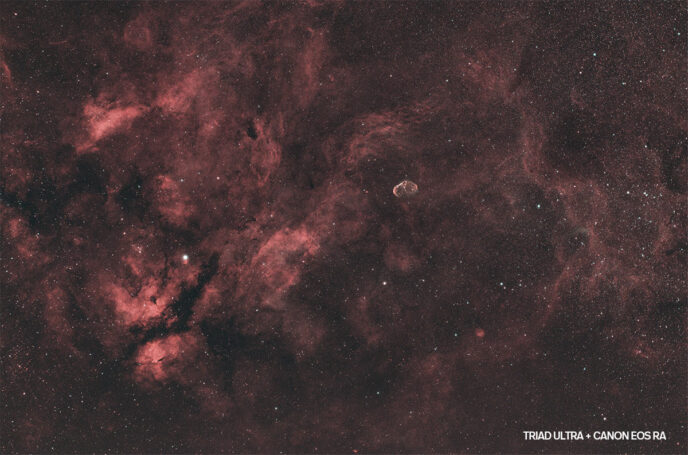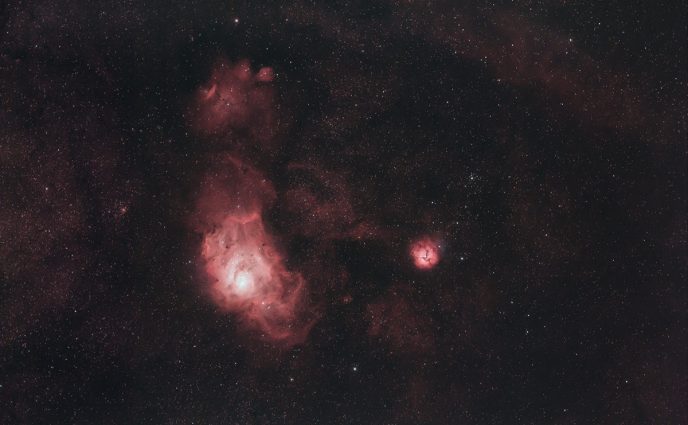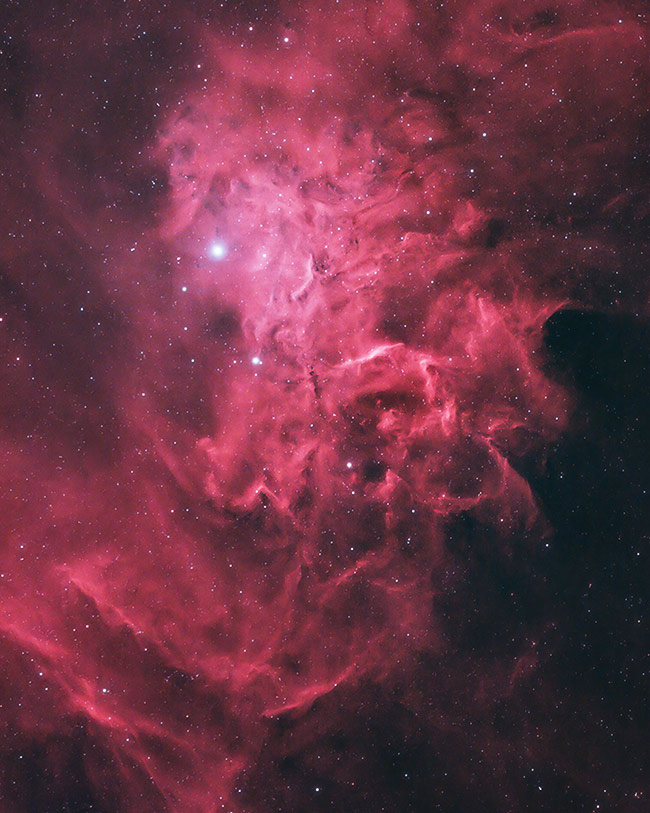OPT Triad Ultra Filter
I’ve been lucky enough to test the OPT Triad filter (Radian Telescopes) for astrophotography in the backyard. This is a 2″ quad-band narrowband filter that collects light in 4 bandpasses, Ha, OIII, SII, and H-Beta.
The “Ultra” version of the filter improves upon the previous tri-band version, now with an even narrower band-passes, and the inclusion of Sulfur II (SII). In theory, this creates images with more contrast and better separation between the H-beta and OIII channels.
Video: My results using a DSLR Camera
The Triad Ultra filter was designed to be used primarily with color cameras, and I have found it to be an extremely useful DSLR filter.
OPT Triad Ultra Filter Review
If you are wondering what the breakdown of the bandpasses (in nanometers) are for this quad-band filter, here it is:
- Hydrogen-beta: 5nm
- Oxygen III: 4nm
- Hydrogen-alpha: 4nm
- Sulfur II: 4nm
It’s worth noting that the OPT website states that telescopes with focal ratios faster than F/4 will move the transmission off-band. This doesn’t mean that if your telescope is F/2 (like my Celestron 8″ RASA), that it is not compatible with this filter, it just means that the images will have about an 0.8nm band-shift.
The following video provides some insight into the data collected using the Triad Ultra filter, and what it’s like to process an image captured in 4 isolated wavelengths. In this article, I will review the performance of this light pollution filter when used with a DSLR camera, and a dedicated astronomy camera.
As you may have noticed, I compared the Triad Ultra filter (Radian Telescopes) to the STC Astro Duo-Narrowband filter. Both of these filters allow you to capture full-color images from the light they collect, but a little post-processing is needed to balance the colors.
For example, images I capture using the ASI294MC Pro always have an overall green cast to them. This is totally normal, and can easily be adjusted by using levels in Adobe Photoshop. Setting the white balance of an astrophotography image in post-processing is typical of any workflow.
As you can see from the transmission graph above, the OPT Triad Ultra filter isolates light wavelengths in the HB, OIII, Ha, and SII bandpasses. To understand what these mean in terms of your astrophotography images using a color camera, please see the following article:
Capturing Narrowband Images with a Color Camera
Results using the Canon EOS Ra
The Canon EOS Ra is a mirrorless astrophotography camera and one that matches the Triad Ultra filter perfectly.
The following image was captured using the EOS Ra, a William Optics RedCat 51, and the Triad Ultra filter. The images were 5-minutes long each, at ISO 3200.
This is perhaps the best example of why this filter is so useful for amateur astrophotographers shooting in light pollution.
Hydrogen Nebulae in Cygnus. Triad Ultra + Canon EOS Ra.
My backyard is a Bortle Scale Class 7, yet it did not hold me back from capturing an image of the Sadr Region that resembles one from a dark sky site.
The Heart and Soul Nebula
I have taken some of my best astrophotography images to date using the Radian Triad Ultra Filter. The following image of the Heart and Soul Nebula was a great choice for this filter (emission nebulae in constellation Cassiopeia) because of its composition of gases.
I used a color astrophotography camera (Canon EOS Ra) to collect 5-minute exposures on M17 using a Radian Raptor 61 Telescope. The image was captured from my light-polluted backyard in the city (Bortle Scale Class 7).
The Heart and Soul Nebulae. Canon EOS Ra, Radian Triad Ultra Filter, Radian Raptor 61.
At 275mm, the Radian Raptor 61 provides a massive field of view of the night sky. When combined with a full-frame camera sensor, it is possible to capture large nebulae regions like this in a single shot.
I isolated the Soul Nebula into its own image, which was quite impressive in its own right. I highly recommend giving this target a go with the Radian Triad Ultra filter to anyone in the northern hemisphere.
Triad Ultra Filter Example Images
This image really blew me away. I used the 2″ Triad Ultra filter inside of my William Optics RedCat 51 to photograph this ultra-wide deep-sky image of the Sadr region. The camera used was a Canon EOS 60Da, a dedicated astrophotography camera from one of the world’s biggest camera manufacturers.
The hydrogen-alpha clearly makes the biggest impact here, but the quad bandpass nature of this filter made it possible to capture a natural-looking image of the area with a DSLR.
The Sadr Region using the OPT Triad Ultra filter with a Canon 60Da.
Next up, I pointed the RedCat 51 towards the constellation Sagittarius. The Lagoon Nebula and Trifid Nebula are well photographed by amateur astrophotographers and for good reason. The image below uses 30 x 3-minutes (@ ISO 6400) for a grand total of 1 hour and 30 minutes of total integrated exposure time.
The Lagoon and Trifid Nebulae in Sagittarius. OPT Triad Ultra Filter and Canon 60Da.
More Image Examples
If you watched the video The Veil Nebula with a Telescope on YouTube, you may have noticed that I used the OPT Triad Ultra filter with my Canon 60Da once more. This time, I captured the Western Veil Nebula and Pickering’s Triangle using the William Optics Zenithstar 73 APO doublet.
The Triad Ultra filter did a great job of separating the vibrant supernova remnants of the Cygnus Loop from a bright city sky (with a nearly full moon). The following image includes 35 x 4-minute exposures at ISO 1600.
The Western Veil Nebula and Pickering’s Triangle. OPT Triad Ultra and Canon EOS 60Da.
Some of the most spectacular results with this filter were when paired with the QHY268C one-shot-color camera. This is a crop sensor (APS-C) cooled astronomy camera, and I really love the resolution of the images captured with this versatile camera.
The image below was captured using the QHY268C camera, Radian Triad Ultra Filter, and a Sky-Watcher Esprit 150 apochromatic refractor telescope.
The Flaming Star Nebula in Auriga. Radian Triad Ultra Filter + QHY268C CMOS camera.
Interesting to Note
I did experience some odd color banding with the OPT Triad filter with my ZWO ASI294MC Pro. These artifacts were isolated to the red channel of the color spectrum, where the majority of the narrowband details were collected.
I am not alone in this situation, as described in this Cloudy Nights forum post. It appears as though this scenario is only experienced by owners of the ASI294MC Pro, and it is due to the sensor design (Not the OPT Triad Filter).
To get around this, I used a number of gradient removal image processing techniques in Adobe Photoshop to correct the red channel. I will continue to investigate this issue and update this article with my results. This issue did not arise when capturing images using my Canon EOS 60Da DSLR with the Triad Ultra filter.
Related Posts:
- Understanding Narrowband Imaging (with a Monochrome Camera)
- Radian Raptor 61 Review (Astrophotography Telescope)








